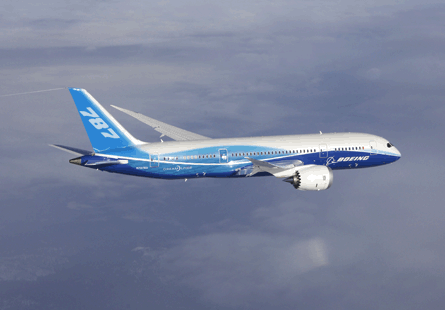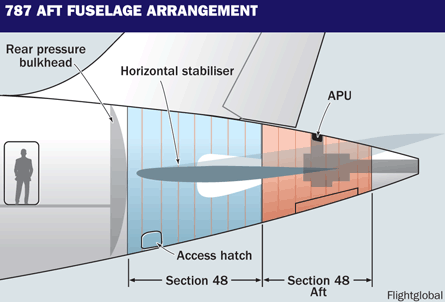Boeing is adding another time-consuming 787 design change after discovering a structural issue with skin attachments in the rear fuselage.
The airframer is aiming to prepare production 787s for delivery by the end of the year, but 12 shear ties - which attach the fuselage frames to the skin - require replacement and many more need reworking, because the initial design failed to take into account thermal fatigue loading of the aluminium parts.
Boeing discovered the problem in December 2009 after it was found that repeated cooling and warming of the unpressurised tail fuselage Sections 48 and 48 aft would result in the shear ties pulling away from the fuselage skin.
While the issue is not expected to affect the flight-test or delivery schedules, the revelation provides additional context to the 24-manufacturing day hold ordered by Boeing on 27 April, citing continued part shortages and design changes.
 |
|---|
© Boeing |
Boeing says the solution, which will be incorporated on all 787s that will be delivered, is a combination of new thicker shear ties. A programme source adds that radius fillers will be employed alongside some existing shear ties.
While a fix has been designed, reaching the area on a fully assembled aircraft is not easy, say sources.
Once the horizontal stabiliser is installed, the space is described by a programme source as "extremely limited" and accessible through a small door in Section 48. The fix requires about 400h to install at suppliers and potentially double that for aircraft already assembled.
"It is a structural issue in that we are modifying the airplanes, but once complete, the structure has full integrity," says Boeing, adding that it will meet all US Federal Aviation Administration requirements.
Rework on the sections for the 23rd aircraft has begun in Charleston, South Carolina and will be completed in Everett, Washington, as will the 24th aircraft.
The same changes are required for aircraft four to 22, including three of the six flight-test Dreamliners, which will eventually be delivered. A permanent design solution is planned for introduction with aircraft No 55.
From aircraft 25, the shear tie modification will be performed in Charleston and South Korea, respectively.
The 24-manufacturing day hold does not represent a new production schedule as the 787 ramp-up continues. Rather, the pace of deliveries will quicken as the time between rate breaks is reduced.
One programme source says the shear tie issue was an important driver for the 24-manufacturing day hold, while Boeing downplayed the issue as being on a longer list of contributing factors.
Holding structural sections at suppliers, particularly the aft fuselage, allows for the completion of required engineering along with significantly easier access by crews to address the rework.
ALUMINIUM SHEAR TIES IN 787 REAR FUSELAGE SECTIONS REPLACED OR REWORKED
The structural frames inside the Boeing 787's rear fuselage Sections 48 and 48 Aft are attached to the carbonfibre skin using composite and aluminium shear ties.
 |
|---|
The aluminium shear ties, found to separate from the fuselage skin, are spread across these two unpressurised sections and will require replacement of 12 and rework of "many more", says Boeing. Access to the Section 48 and 48 Aft is through an access door on the underside of the fuselage and space is limited due to the horizontal stabiliser and auxiliary power unit.
Section 48 is fabricated by Boeing Charleston, formerly Vought Aircraft Industries, while Section 48 Aft is produced by Korea Aerospace Industries in South Korea.
Source: Flight International























